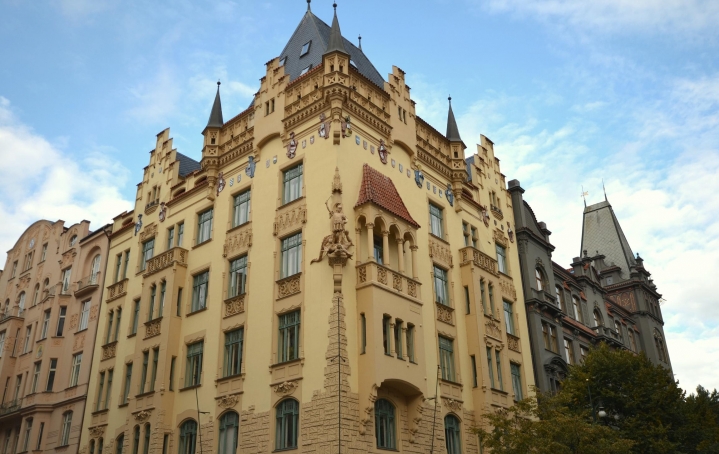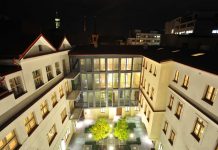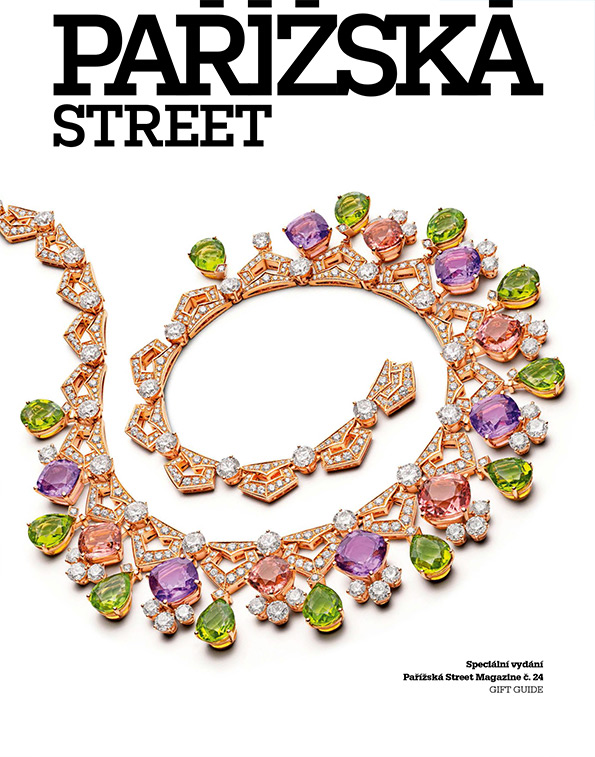Pařížská Street is lined by tenement houses in the Viennese Secession style. However, some of them look distinctly different from the others. One of these diverse houses is located on the corner where Pařížská and Široká meet.
You cannot miss it. Whether you approach it from Pařížská or Široká, this House is the dominant feature of both streets. It differs from the others with its Gothic décor and turrets, which are meant to give the impression of a medieval castle. That was precisely the intention of the authors who took part in its construction. Nowadays this house has an important historical and artistic value, in its time, though, and even many years afterwards, contemporary architects considered it to be a monstrosity. It wasn’t until many years later that professional circles finally accepted it.
Well-kept appearance
But let’s go back to the very beginning. The house was built in 1905 as a tenement building. Its architect was Josef Blecha, who designed several other houses in Pařížská Street. Although the House has undergone several alterations in its more than hundred years of existence, the building’s exterior has remained the same. Even today it still serves as a tenement building; on the ground floor, however, there is a shop and it is here that Bulgari has found its Prague home.
The building has a basement, a ground floor, four other floors and an attic. The door on the ground floor has been given a modern look. One of the building’s most attractive elements are the oriels, of which there are several. Some of them hold up a balcony or loggia.
The facade onto both Pařížská and Široká is finished off with a cornice with a parapet and a segmented roof. Looking at these elements as a whole we witness a dramatic formation.
The saddle roof is also artistically valuable and its edges are complemented by transverse dormers. These end in gables.
Gothic Castle
When you walk up to the building you cannot help noticing the monumental impression it gives off. Compared to its neighbours, it does indeed look totally different. This is due to the building’s gothic decor and the rough block-effect of the plasterwork, which is evident on the building’s ground floor and first floor. There are also indented corbels bearing the oriels and numerous other elements inspired by Gothic architecture. The building also has elements that are more often seen on Medieval Gothic castles. They are wimpergs, balustrades and raised coats-of-arms. Although they have a Viennese Secession make-over.
Another distinctive feature of the building is the console with a statue of St. George slaying the dragon, which is recessed into the corner of the third floor.
Damaged Interior
Naturally enough every house has an interior, and this building is no different. Although it underwent changes in the 1990’s and its original appearance was damaged, the building’s interior still remains architecturally valuable. Unfortunately, however, it remains hidden and most people cannot see it.
Of the building’s original appearance the design of the vestibule has remained the same. This is dominated by a tile mosaic and stucco decorations on the ceilings. The décor is also partly preserved in the large, multi-roomed apartments.
The Legend of George and the Dragon
According to legend at the beginning of the third century a dragonsettled in one Libyan town and guarded the water source. Every day the inhabitants had to lure the dragon from its nest to get to the water. The lure was a human sacrifice, for which they drew lots. One day, however, the beautiful princess drew the lot. George happened to pass by when the royal daughter was presented to the dragon. He believed in Christ, and this belief helped him defeat the Dragon and rescue the Princess. As a sign of their gratitude the grateful citizens then abandoned paganism and embraced Christianity.
Antonín Sova
For several years the house on the corner of Pařížská and Široká was the home of the Czech poet and writer Antonín Sova. Antonín Sova, was also the first Director of the Municipal Library in Prague.
He was born in 1864 in Pacov, where, about 64 years later, he also died. His work was influenced by symbolism, impressionism as well as realism. In his works he criticised society, sought out moral and social values and discovered patriotism, for example, in the symbolist anthology Broken Souls.
He lived and worked in the house on the corner of Pařížská and Široká from 1918-1925. This is also commemorated by a plaque, which is located on the Široká side of the building.
Gothic dictionary
Although the architect Josef Blecha designed a Viennese Secession building he used many Gothic elements in it.
corbel – a Gothic square stone beam horizontally extending from the masonry and usually bearing an oriel, garderobe or gallery
wimperg – a triangular gable above the portals and windows to highlight verticality
balustrade – decorative railings that are made using low columns














